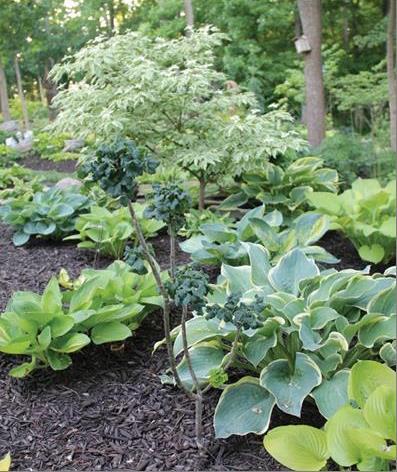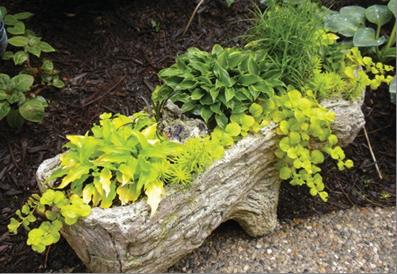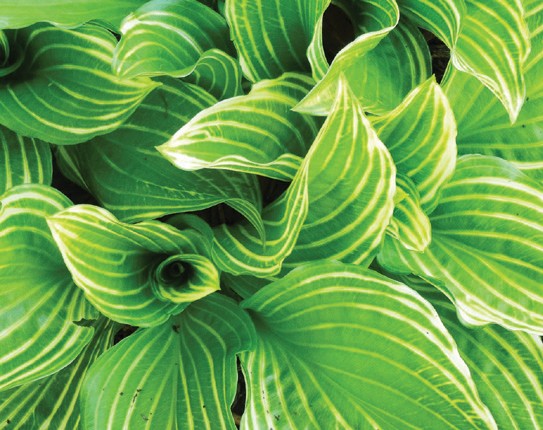|
Goodwin’s
garden winds through a series of his own hybrids. Hosta ‘Spartan Arrow’
has 9-inch, dark green foliage that is very wavy and dense, with a
sharp lancelike shape. It also has pale purple flowers on 20-inch
scapes in midsummer. It is the spear shape that makes this hosta
distinct. Hosta ‘Hot Lips’
(bottom right) and a bit of spring bamboo accents the front of the
large rock (right).
|
|
I
jumped at the chance to
interview one of the “masters,” so when Randy Goodwin walked inside
from his
garden and greeted me, I thrust my hand forward to clasp his. I wanted
to shake
hands gardener-to-gardener, before he could wash the soil of wisdom
from his
palm.
Like
a wide-eyed music groupie who gets a personal interview and a seat
in the front row of a sold-out concert, I asked Randy Goodwin to name
some of
his favorite creations.
Pulling
them up on his computer, he answered: “‘Battlestar’, ‘Worldly
Treasure’,
‘Daisy Doolittle’ — a mini, named after our shih tzu — ‘Majestic’,
‘Pacific
Sunset’, ‘Prime Meridian’, ‘Rain Forest’, ‘Shade Parade’, ‘Shady
Lover’,
‘Summer Warrior’, ‘Tara’ and ‘Jen’, both named after our daughters.” |
|
I
tried to act professional and not jump up and down screaming, “Oh, my
gosh, I’ve got that one — YOU created that one too?”
Goodwin
is one of only
20 hosta hybridizers in the U. S. — one of the many from Indiana. “We
have good
growing conditions,” he explained.
His
very first hybrid
hosta ‘Indiana Knight’, was named after Bobby Knight in 1989. And like
an
artist promoting his new album, Goodwin added, “I’ve got two new ones
coming
out: ‘Brocade’ and ‘Porcelain’.”
Walking
through their
showroom-decorated home, Goodwin’s wife Susie asked, “Do you know how
he comes
up with names for his new hostas? Paint store colors!” she answered. |
 |
|
 |
| Left:
Goodwin has an eye for unique specimen plants, including dwarf ginkgoes
(Ginkgo biloba). Pictured are Cornus kousa ‘Wolf Eyes’ (light green,
white interior variegated foliage) also known as a Chinese dogwood,
which puts on a six-week ivory white “floral show” with its bracts in
the spring. The dwarf english oak in the front is Quercus robur
‘General Pulaski’ with crinkled dark green leaves. Named for an officer
in the American civil war, this upright, deciduous tree will grow to 6
feet tall in 10 years and be only 1½ feet wide. Above: Goodwin’s
mini-garden won the 2012 National Hosta Show’s Trough Division. |
|
 |
|
 |
| Randy’s
landscaping has earned him the moniker “The Man who Paints with
Hostas.” He suggests planting hostas in various shapes, shades and
groupings to help the eye follow the different cultivars. Left: Randy
and Susie Goodwin sit in front of their Green County stone water
feature. |
|
|
“Those
son-of-a-guns, whoever gets their hybrids marketed first gets to use
their chosen name,” Goodwin explained. “Hybridizers have to keep the
name quiet even if it’s registered — the name isn’t safe until it’s
marketed.”
The hundreds of hostas in Randy Goodwin’s garden
whisper his autobiography.Goodwin has hybridized and registered 80
different hostas over the past 25 years, 40 have been introduced and he
is currently watching another hundred to see if they are
distinct.Goodwin explains that it takes seven years to produce a plant
that is worthy to be on the market.
I asked him how he got into
hybridizing hostas, which are the number-one shade perennial in
America. He responded, “The more you get into something, the more
avenues that are opened up — when I saw the prices people were getting
for hostas … I guess I’m a mercantilist at heart.
“What I enjoy
more than anything is landscaping; it’s my way of leaving the world
with something more than what I came in with.” Goodwin explained
that he painted a few sum-mers like many teachers, but after
he
put in his first shade garden he began to get requests. “I ended up
landscaping from the age of 44 to 67 and designed and installed 44
backyard shade gardens, which also put my two daughters through
Purdue.” His landscaping has earned him the moniker “The Man who Paints
with Hostas.”
While
working as a fifth-grade teacher in Speedway School Corporation in
Indianapolis, Goodwin first became interested in the Hosta genus when
living in Pike Township, after building a house on a wooded lot. After
a trip to Soules Garden in 1987, “I thought I was in the middle of a
Brazilian rain forest — after that day I was hooked. That same year
Marge (Soules) went to the (American Hosta Society) national
convention and when she returned she informed our small group of seven
original Indianapolis Hosta Society members that we were going to host
a Hosta National Convention in Indianapolis — which we did in 1989,
1997 and 2007.
 |
| Hosta rectifolia
'Amime' |
|
|
Although
retired from his classroom of fifth-graders since 2001, Goodwin
continues to teach, explaining that hostas have
been grown in gardens in East Asia for centuries. The American Hosta
Society reports that Chinese documents mention hostas as
early as
the Han Dynasty 206 B.C. through 220 A.D., and in Japan they show up in
scripts preceding the Nara period beginning in 710 A.D. By 1830, hostas
were imported first in Europe, reaching North America just a few years
later. The American Hosta Society was initiated in 1968. Goodwin noted
vast changes were seen in American hosta growers when hybridization
began around 1978 — beginning with about 25 species,
there are now well over 5,000 cultivars.
A
Master Leaf Show Judge and chairman for the three- leveled award system
of the American Hosta Society Benedict Garden Performance Medal,
Goodwin enjoys displaying his leaves at hosta shows.
Five years
ago, Goodwin and his wife, Susie, moved from Indianapolis to Zionsville
— with their award-winning hostas, carefully watering, potting and
replanting more than 1,200 plants. He estimated that he now has about
500 different culti- vars represented in his garden.
When asked
what was the most he ever spent on a hosta, he recalls, “$250 for Hosta
‘Spilt Milk’, back when it was rare, but I traded a couple of plants
and a truck full of mulch.” He notes that prices have really dropped
since the advent of tissue culture for hostas, since about 1990
“I’m like Will Rogers, I’ve never met a hosta I didn’t like,” Goodwin
added.
|
 |
|
| Goodwin’s
garden changes annually, but always includes a myriad of color and
interesting specimens. |
Editor's
note: Reprinted with permission by Indiana Gardening
magazine, a State-by-State Gardening publication, http://www.indianagardeningmag.com/
|
| H. 'Majesty' |
|
| |
|


